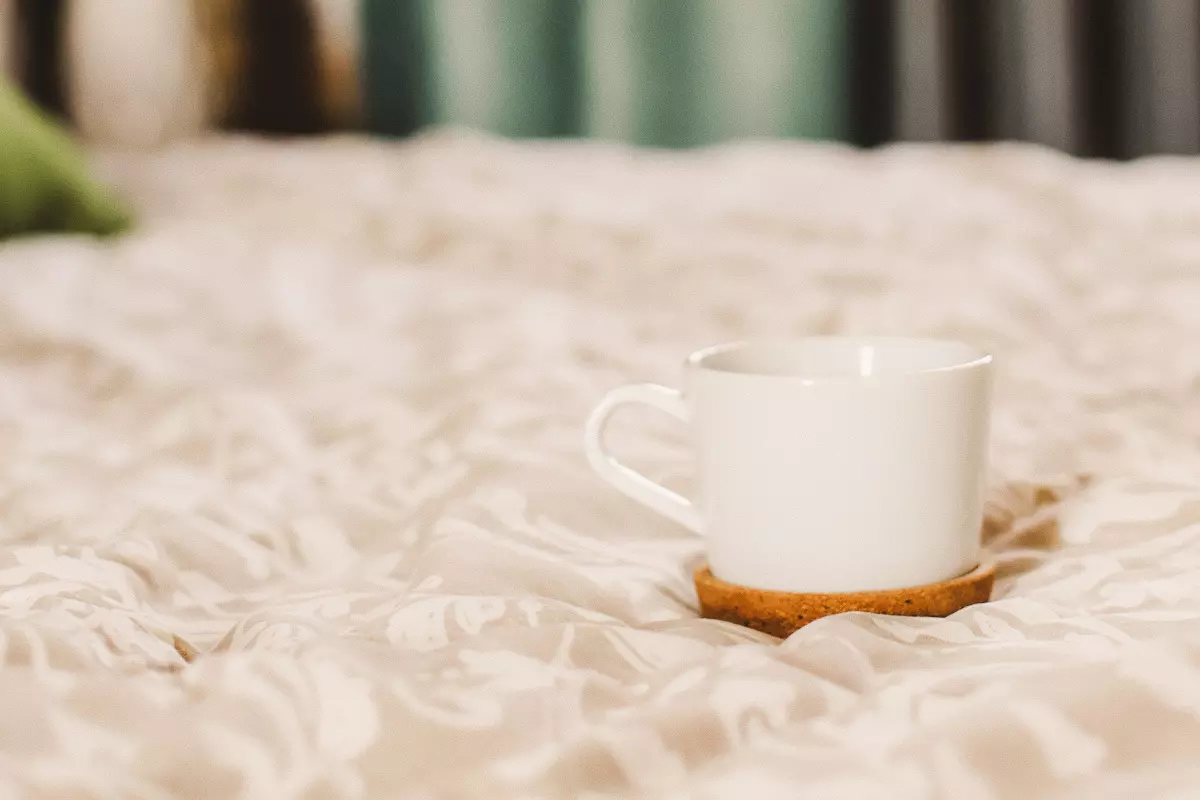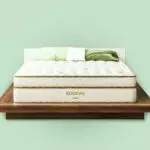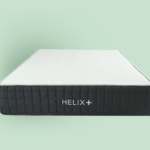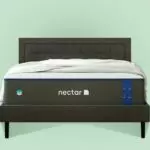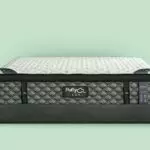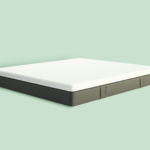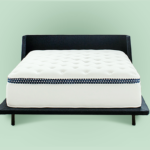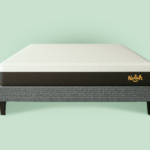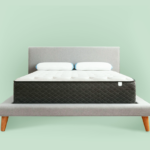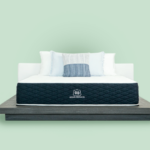Table of Contents
Back pain and sleep have a difficult relationship. If your pain is severe, you might be unable to get a restful night’s sleep, but lack of sleep can worsen pain. This cycle can be extremely frustrating, and it can take a serious toll on mental health.
The relationship between sleep and pain makes it crucial to find the best mattress for back pain. The right mattress depends greatly on your individual needs, but the right amount of comfort and support—whatever that may be for you—is imperative. To help improve your journey to quality sleep, we’ve selected the 10 best mattresses for back pain based on results from our own testing methods. We also surveyed 600 mattress owners and consulted sleep experts, physical and occupational therapists, and pain specialists to identify features that benefit back pain.
Best mattress for back pain overall
The Saatva Classic is our pick for the best mattress for back pain overall because of how effectively the supportive, double-layer innerspring coils help sleepers maintain a neutral spine at night. Our tester noted that while the soft Euro top provided the comfort of pressure relief, the mattress still provided the spine support they needed. Knowing different sleepers have different comfort needs, we appreciate that this mattress is available in three firmness options to suit any preferred sleep position or body type.
Our pick of the best mattresses for back pain
- Saatva Classic: Best overall mattress for back pain
- Helix Plus: Best mattress for stomach sleepers
- Nectar Original: Best value mattress for back pain
- Puffy Lux Hybrid: Best mattress for back and hip pain
- Emma Original: Best mattress for neck and back pain
- DreamCloud Original: Best hybrid mattress for back pain
- WinkBed Original: Best mattress for lower back pain
- Nolah Original: Best mattress for side sleepers
- Bear Original: Best mattress for back sleepers
- Brooklyn Bedding Signature Hybrid: Best mattress for combination sleepers
HelpGuide Handbook mattresses for back pain
Here are the five most important things to know about mattresses for back pain:
Compare the best mattresses for back pain in 2024
| Price | $1,295–$2,372 | $812–$1,812 | $700–$2,156 | $2,195–$4,798 | $412–911 | $1,169–$2,998 | $1,149–$2,049 | $1,499–$3,918 | $665–$1,599 |
| Firmness | 7/10 | 8/10 | 6.5/10 | 5.5/10 | 7/10 | 6.5/10 | 6.5/10 | 5/10 | 6/10 |
| Material | Innerspring-hybrid | Hybrid | Memory Foam | Hybrid | Foam | Hybrid | Hybrid | Memory foam | Hybrid |
| Warranty | Lifetime | 10 years | Lifetime | Lifetime | 10 years | Lifetime | Lifetime | 10 years | 10 years |
| Trial period | 365 nights | 100 nights | 365 nights | 101 nights | 365 nights | 365 nights | 120 nights | 120 nights | 120 nights |
| Best for | Sleepers with back pain who like responsive beds | Sleepers with back pain who are searching for a hybrid bed | Sleepers with back pain who want a value mattress | Sleepers with back pain and hip pain | Sleepers with back pain and neck pain | Sleepers with lower back pain | Sleepers with Back pain who are stomach sleepers | Sleepers with back pain who are side sleepers | Sleepers with back pain who switch sleeping positions |
The best mattresses for back pain reviews
Best mattress for back pain overall: Saatva Classic
Our final verdict on the Saatva Classic
Historically, the best mattresses for back pain are medium-firm to firm mattresses. Luckily, the Saatva Classic provides three different firmness options, providing spinal support and lumbar cushioning for a variety of body types and sleeping positions. In addition, we found that the classic innerspring feel of this bed offers a responsiveness Good responsiveness means the mattress has a bouncier surface that responds to pressure or the sleeper’s movements, making it easier to move around and switch positions. that helps keep sleepers on top of the bed, rather than letting them sink too far into the mattress and throwing their spine out of alignment.
From our tester
“I felt sufficient cushioning from Saatva’s pillow top, as well as lots of support from the top pocket coil layer.”
While testing the Saatva Classic in our mattress studio, we analyzed how we felt while back sleeping, side sleeping, stomach sleeping, and combination sleeping People who sleep in multiple positions throughout the night. For example, a person might be a back-and-side sleeper or a stomach-and-back sleeper. . During this test, we recorded feeling well-supported in all sleeping positions. We also think this bed offers good overall support, edge support Edge support is the bed’s strength and stability around the perimeter. , and pressure relief.
However, we do think couples who awaken easily during the night should find a bed with better motion isolation. It scored poorly on our motion isolation. The containment of movement on one area of a mattress so it doesn’t impact other areas. test, meaning you and your partner are likely to feel each other’s larger movements at night.
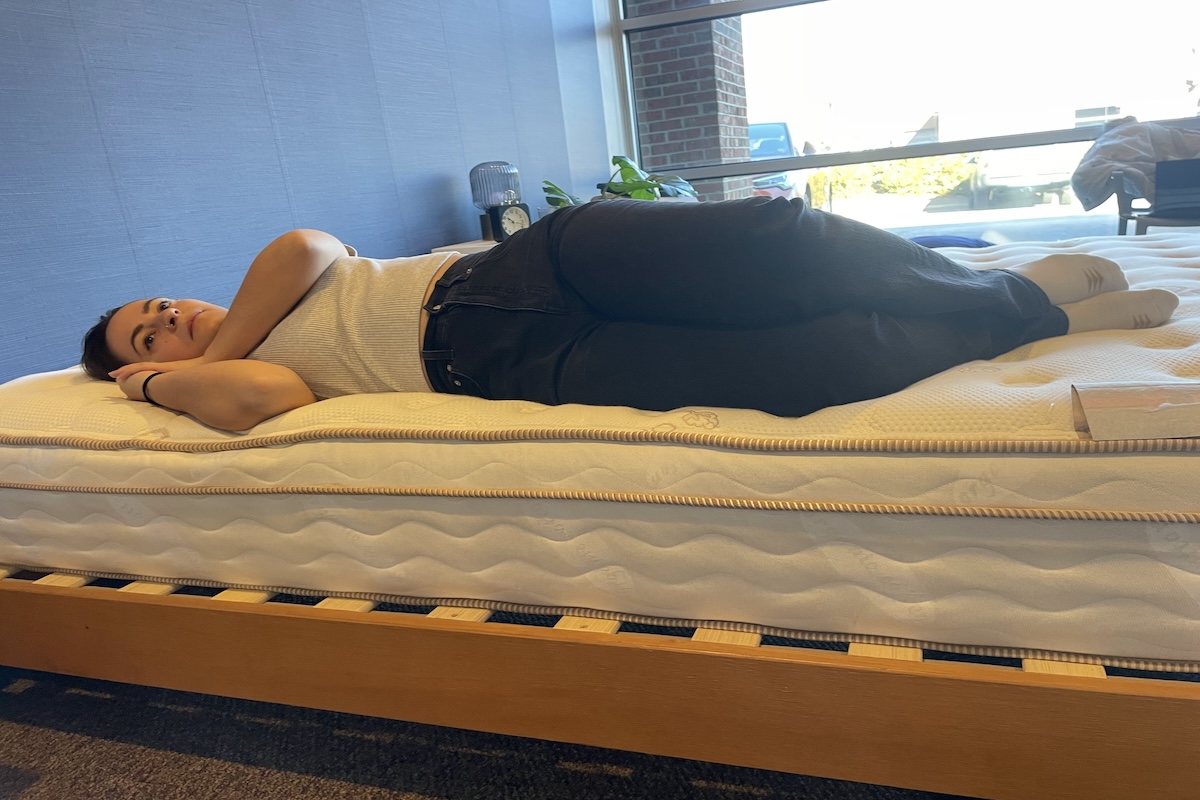
To learn more, read our Saatva mattress review.
Best mattress for stomach sleepers: Helix Plus
Our final verdict on the Helix Plus
As a company, Helix is well-known for its assortment of hybrid A type of mattress made with both foam layers and spring layers. mattresses at varying firmness levels and prices. The Helix Plus is specifically geared toward larger bodies, and our team found that it offers the support and the pressure relief needed to alleviate back pain.
From our tester
“Lightweight, average-weight, and heavyweight stomach sleepers will be comfortable on the Helix Plus, which prioritizes firmness and support.”
This bed’s eight out of 10 firmness rating is ideal for supporting stomach sleepers of varying body types. Those sleeping in the prone position require a firm, supportive mattress that keeps its shape throughout the night.
Typically, if a stomach sleeper rests on a surface that’s too soft, their hips will sink into the material, and their spine will bow out of alignment, causing back pain. Stomach sleepers shouldn’t have that problem on the Helix Plus—its firmness, extra-sturdy coils, and high-density foam is designed to keep stomach sleepers’ hips elevated and in a neutral alignment with the rest of the spine.
While this bed’s firmness level makes it less ideal for average side sleepers, most higher-weight sleepers should be comfortable in all sleeping positions.

Learn more in our Helix mattress review.
Best value mattress for back pain: Nectar Original
Our final verdict on the Nectar Original
Treating back pain can be expensive enough, and the last thing some shoppers want to do is spend thousands of dollars on a mattress. That’s where the Nectar Original comes in. It’s a quality yet budget-friendly all-foam mattress that’s more than equipped to tackle the frustrations of back pain. After considering discounts, shoppers can often find a queen-size mattress for less than $700.
From our tester
“Like many traditional memory foam beds, we found it to excel in pressure relief, which is beneficial for those suffering from joint pain.”
We gave the Nectar Original a firmness score of 6.5 out of 10, making it a true medium-firm bed, which offers the ideal balance to alleviate and prevent back pain. There are three layers in this mattress, and though it’s a simple construction, we think it’s an effective one.
Gel-infused memory foam provides a slow response to movement and cradles the areas needing relief. It also serves to fill in the gap at the lower back, preventing strain at the lumbar region. Soft conventional foam in the middle serves to transition the sleeper to the firmer layer, and the high-density foam at the bottom provides support.
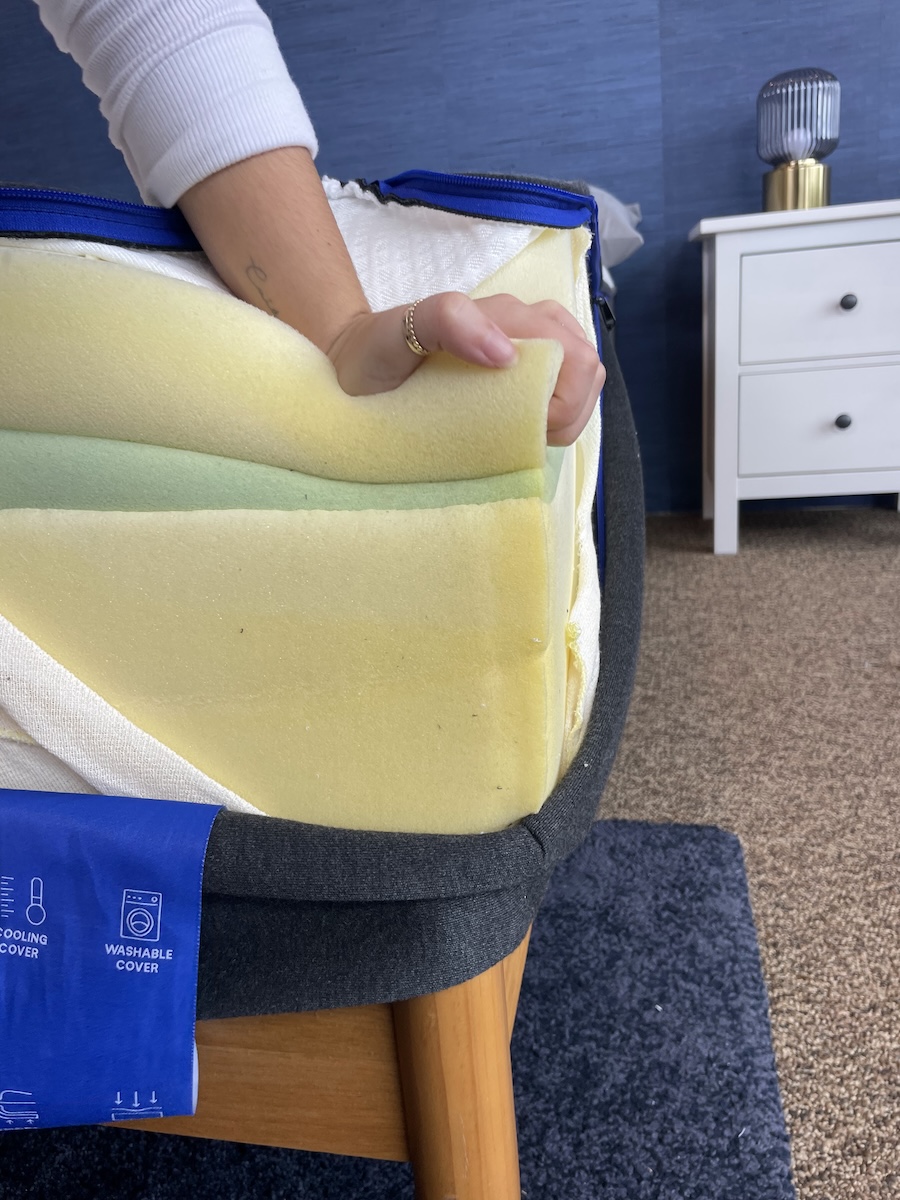
To learn more, read our Nectar mattress review.
Best mattress for back and hip pain: Puffy Lux Hybrid
Our final verdict on the Puffy Lux Hybrid
In our experience, to alleviate both back and hip pain you need a mattress that’s a little softer than a medium-firm, and it should provide sufficient pressure relief to cushion the joints and lumbar region while keeping the hips elevated. We measured the Puffy Lux Hybrid at a 5.5 out of 10 on our firmness scale, so it’s right in this range.
From our tester
“I’m definitely a huge fan of this mattress for side sleepers. And its gel infusions and breathable coils make it a standout option for hot sleepers.”
While testing this bed-in-a-box at our mattress studio, we were comfortable while back sleeping and side sleeping. We felt supported, and the dual foam comfort layer cradled our hips and shoulders while laying on our sides and cushioned the lumbar region of our backs. We also noticed some mild relief on our shoulders. Overall, this bed has a softer feel than the other hybrids in this roundup.
We feel confident the Puffy Lux Hybrid is a fantastic fit for alleviating and preventing both back and hip pain because it relieved pressure at the joints and lifted and supported our hips, helping keep our spines aligned.
To learn more about Puffy mattresses, read our Puffy Cloud review.
Best mattress for neck and back pain: Emma Original
Our final verdict on the Emma Original
Managing to tackle both neck pain and back pain simultaneously can be quite the task. And it can be even more stressful to sort through all your options online. Luckily, the Emma Original takes the stress away. We recommend medium-firm beds for those with back and neck pain, as a balanced bed can guide the entire spine into a neutral alignment. Scoring a seven out of 10 on our firmness scale, we think the Emma Original gives the comfort and support needed for a painless slumber.
From our tester
“The Emma prioritizes support and an ‘on top of’ feel, so we mostly recommend it to back sleepers, stomach sleepers, and combination sleepers.”
Back sleeping and side sleeping are the healthiest for neck pain, and the Emma Original should suit most back sleepers, as well as some side sleepers who appreciate a firmer feel. But the Emma Original also supports neutral alignment for stomach sleepers with neck pain. The zoned support at the bottom of the mattress makes it softer and firmer in the right places.
The Emma Original scored well in edge support Edge support is the bed’s strength and stability around the perimeter. and overall support, meaning it should maintain its shape throughout the night. You shouldn’t feel like you’re sinking through the material too far, which ensures your spine doesn’t bend too far out of alignment.
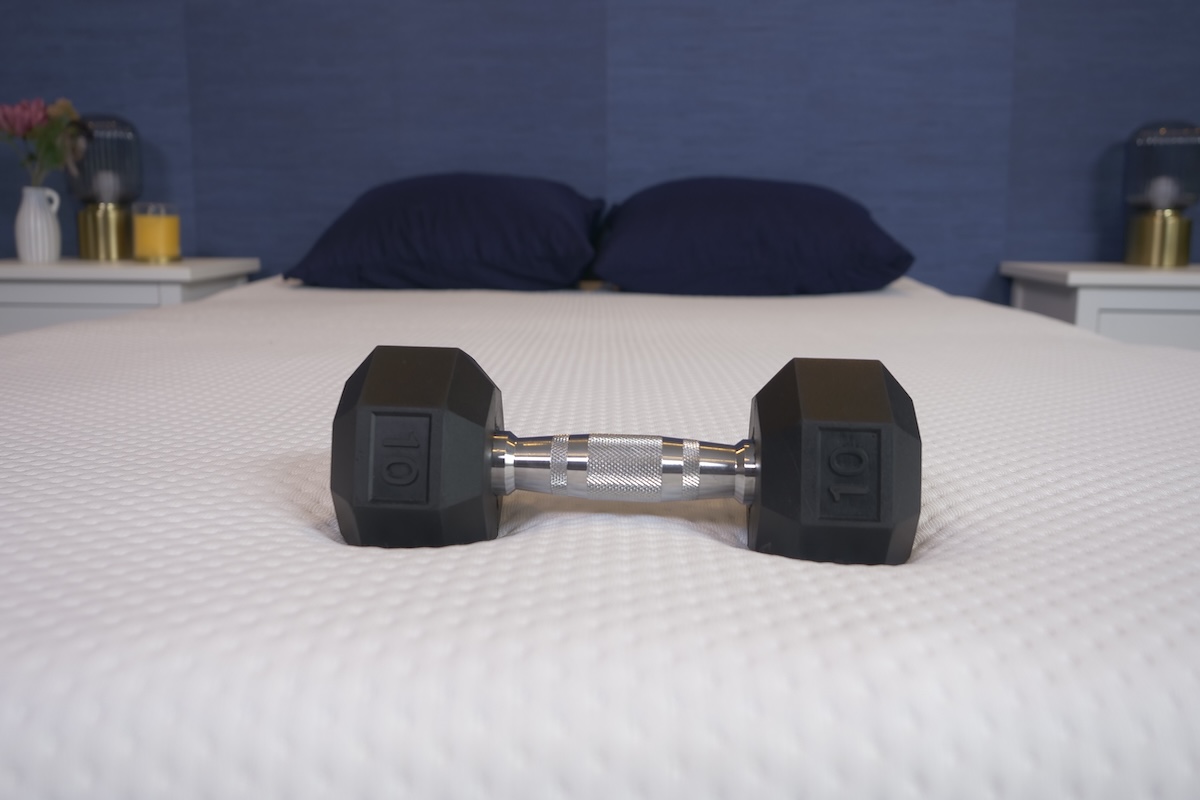
Best hybrid mattress for back pain: The DreamCloud
Our final verdict on the DreamCloud
Hybrid mattresses combine foam and coils, mixing the strengths of both memory foam beds and innersprings. The DreamCloud is our favorite example of this, as it’s an incredibly well-rounded model that uses soft memory foam and individually wrapped coils to create a true medium-firm (6.5 out of 10) sleeping surface for alleviating back pain.
From our tester
“This mattress is really middle-of-the-road—while there’s give, it still feels firm and my weight is evenly distributed.”
We found this mattress comfortable for back sleeping and noticed the DreamCloud evenly distributed our weight. While some may want a bit more pressure relief, we felt it was comfortable for side sleeping. Our spines were aligned and there was enough cushioning from the mattress’s cashmere cover and foam comfort layer.
We tested responsiveness by using a 10-pound weight and watching how the material responded to pressure. From the results, we determined it’s responsive enough for combination sleepers who switch positions.
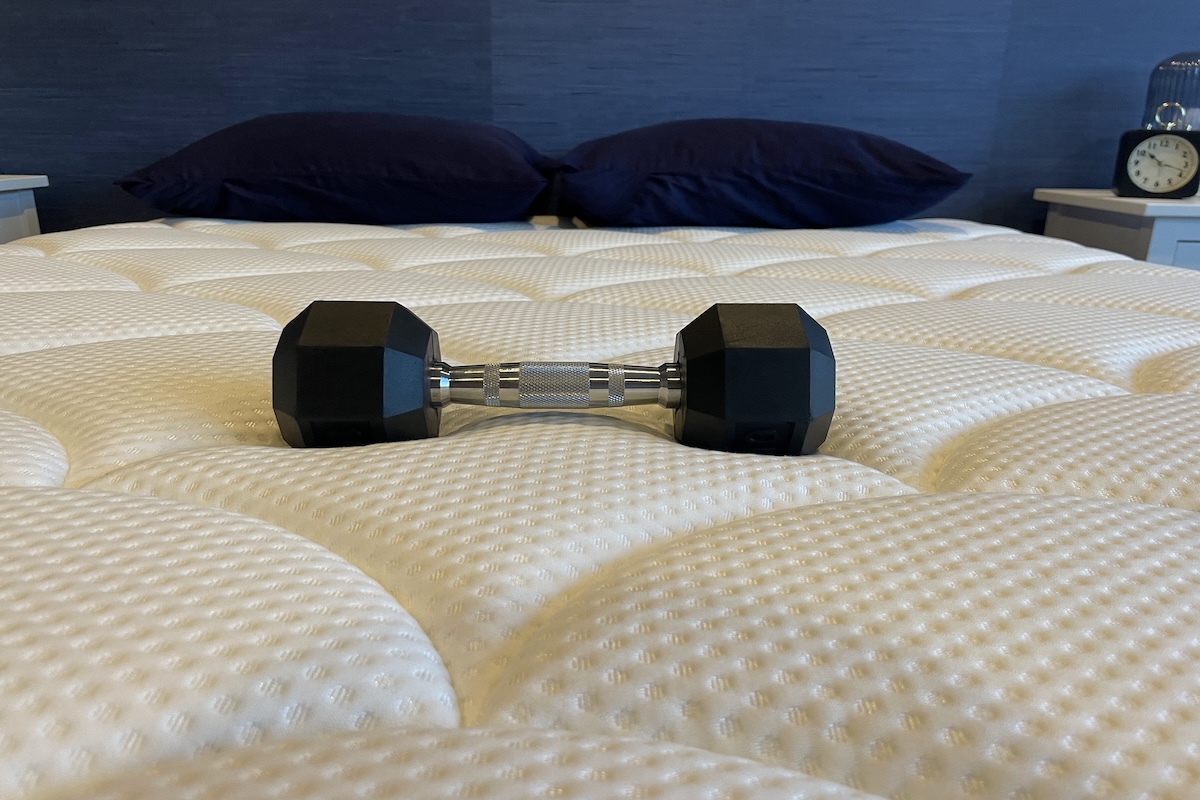
Read more in our in-depth DreamCloud mattress review.
Best mattress for lower back pain: WinkBed
Our final verdict on the WinkBed
During sleep, lower back pain is exacerbated when a mattress fails to support the natural alignment of the spine. If a mattress fails to keep the lower body lifted, or if there’s a gap between the mattress and the lumbar region, it can be extremely difficult to find relief in the lower back. We’ve found that The WinkBed addresses this issue.
From our tester
“Resting on The WinkBed, we did notice that the comfort foam layers adequately filled in the lower back and gave some pressure relief at the lumbar region. This should make it a good mattress for back sleeping. ”
The WinkBed scored impressively on many of our tests, from support and edge support to pressure relief. While testing this mattress in the back sleeping position, we experienced good contouring and give. Our weight was evenly distributed, and our spines felt neutral. The pillow top and memory foam comfort layer nestled in our lumbar region and gave it the necessary cushioning, while the individually cased coils kept us lifted. We’re confident that most people should experience lower back pain relief with The WinkBed, especially with the variety of firmness options catering to different types of sleepers.

Best mattress for side sleepers with back pain: Nolah Original
Our final verdict on the Nolah Original
While people with back pain typically require a medium-firm mattress, support is an important component of this. But when side sleepers are searching for the bed of their dreams, the term “pressure relief” should be top of mind. A pressure-relieving mattress prevents the buildup of pressure in sensitive areas. And side sleepers historically put most of their weight on their hips
“Sleeping positions are crucial to maintaining good joint health. Try to sleep on your back or side as best you can. It can take some time to train to fall asleep comfortably, but I strongly recommend it.”
Christian Busch, doctor of physical therapy and owner of WildHawk Physical Therapy in Asheville, North Carolina
As a softer mattress (five out of 10 on the firmness scale) with a memory foam feel, the Nolah Original is a good fit for side sleepers with back pain. We noted that our hips and shoulders sunk into the foam material in a good way and that it did a stellar job of offloading pressure in those areas.
Overall, we found this mattress still had enough structure and pushback to support the torso and keep the spine aligned. That’s why we gave it high marks for support and pressure relief, a tough combo to strike for many foam mattresses.
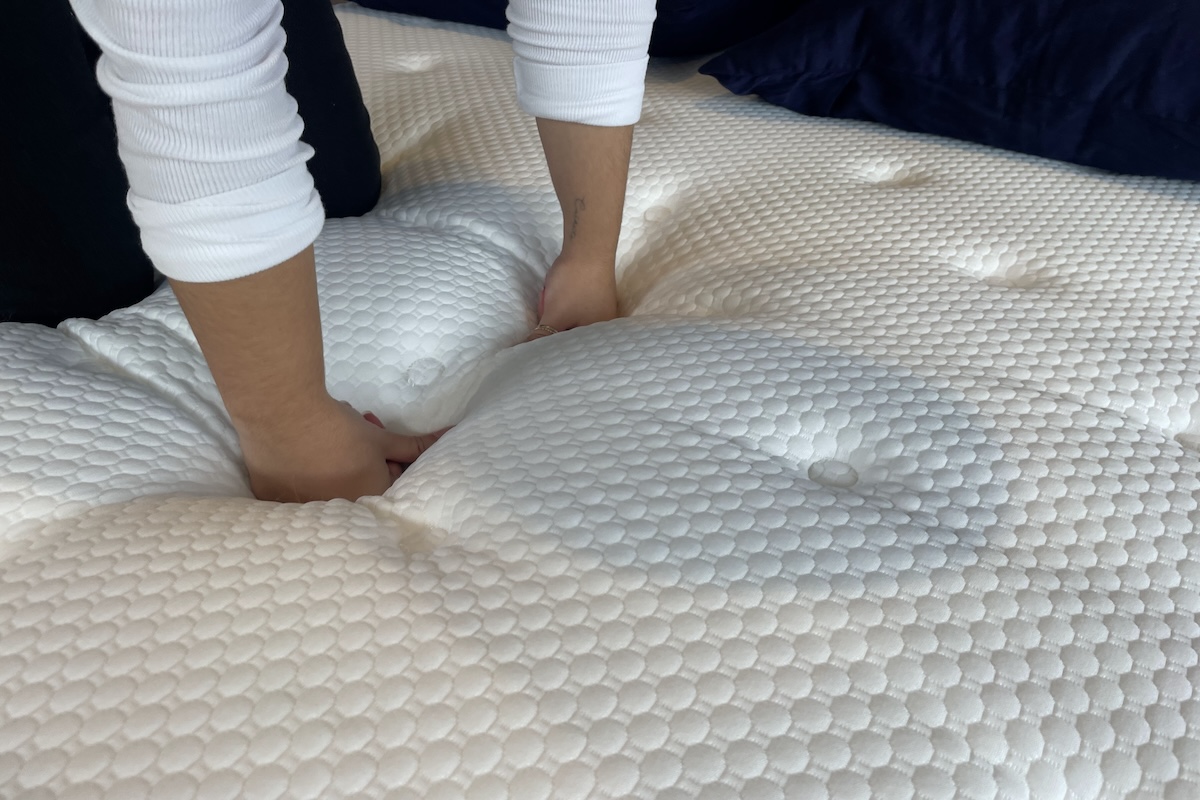
Best mattress for back sleepers with back pain: Bear Original
Our final verdict on the Bear Original
Back sleepers often require the same balanced feel that people with back pain require. This typically means there should be enough cushioning at the lumbar area to fill in the curve there, with enough support to lift the hips and keep them in alignment all night long. The Bear Original, the company’s flagship product, does this beautifully. We think it should work for most back sleepers less than 250 pounds.
From our tester
“It’s a firmer type of memory foam surface versus other more forgiving memory foam surfaces that would make my hips sink down, but this doesn’t do that. ”
We did find this bed on the firmer side, so back sleepers who dislike a firmer feel may not find their match in this bed. But while testing in our studio, we found it scored well in pressure relief (four out of five). Though the brand boasts a more “on top of” feel, you should still receive the necessary cushioning at the lumbar region and the hips.
This bed also scored well in cooling, which isn’t essential to relieving back pain, but it’s one more luxury offered for a good night’s sleep. The last thing people with back pain need is even more discomfort.
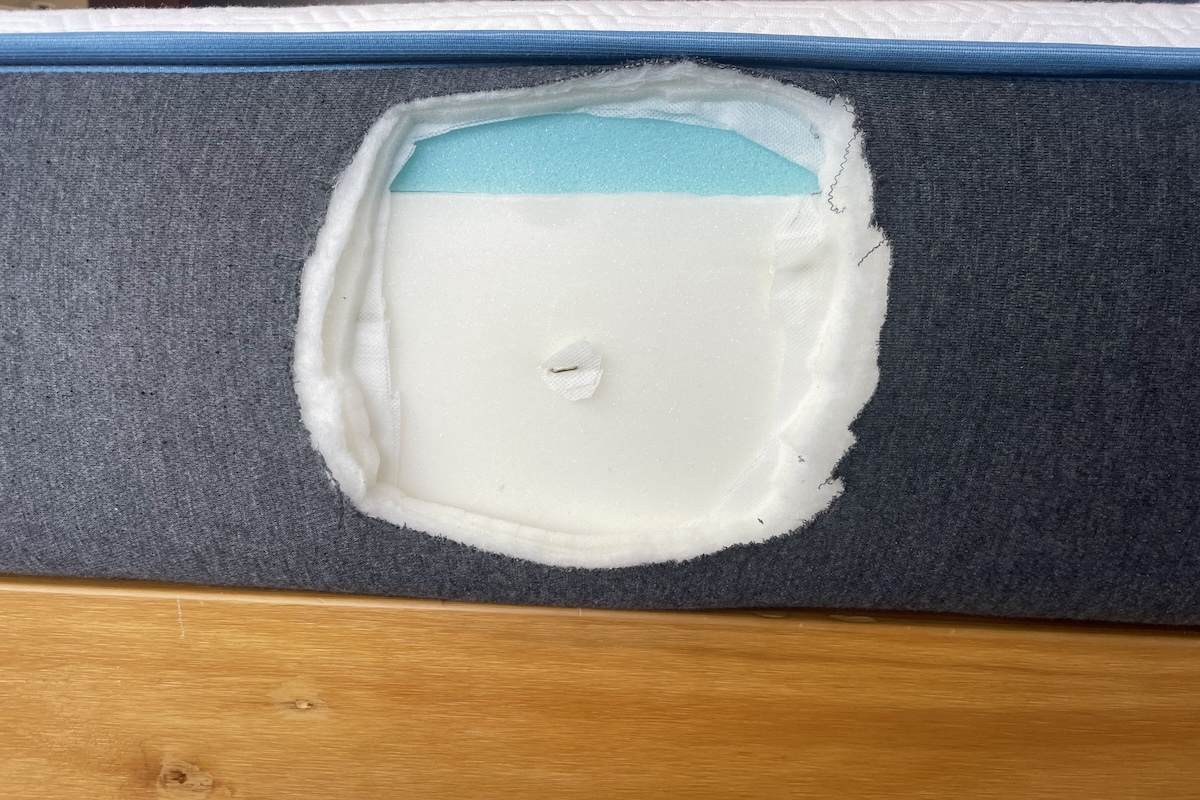
Best mattress for combination sleepers with back pain: Brooklyn Bedding Signature Hybrid
Our final verdict on the Brooklyn Bedding Signature Hybrid
Combination sleepers don’t stay in the same sleeping position the whole night—some people flip-flop between back sleeping and stomach sleeping, while others go from side sleeping to stomach sleeping. There are many different types of combination sleepers, but they all have one thing in common: They need ease of movement. And that’s precisely what the Brooklyn Bedding Signature Hybrid provides.
From our tester
“The Brooklyn Bedding Signature Hybrid proprietary transition foam and bouncy coils allow combination sleepers the ease of movement they need.”
For combination sleepers with back pain, feeling comfortable and supported in multiple positions is crucial. This hybrid mattress uses bouncy, individually wrapped coils to create an “on top of” feel, and with a six out of 10 firmness, it should appeal to back sleepers, side sleepers, and stomach sleepers alike.
During testing, we felt good while back sleeping. We felt our spines were in a neutral position, and the memory foam comfort layer filled in our lower back. We felt our spines remained neutral while side sleeping as well, although those with severe joint pain might need something a little softer. Lastly, we felt our hips were elevated while stomach sleeping.
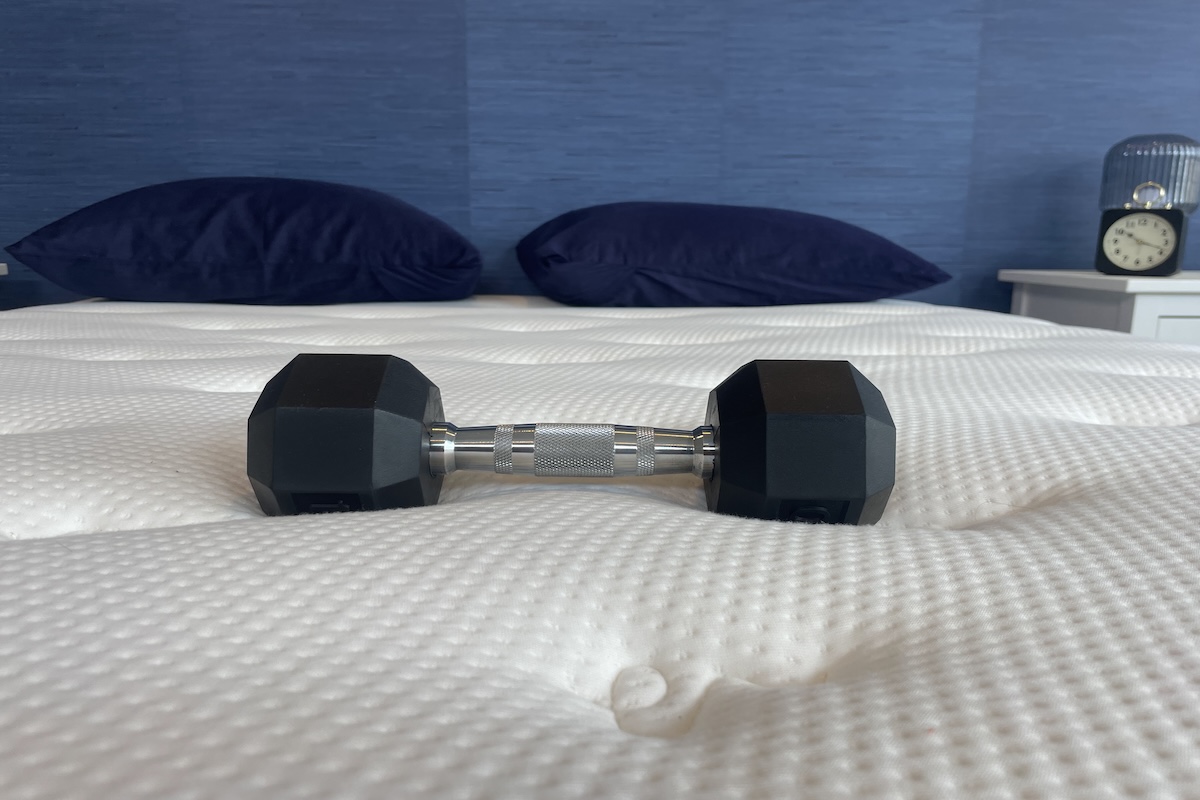
What to consider when buying the best mattress for back pain
Buying a mattress for back pain means considering factors beyond comfort and support. Here’s what to keep in mind.
Firmness level
For back pain, a mattress in the medium-firm range can be a great choice. Because it’s neither too soft nor too firm, it should deliver sufficient support without sacrificing pressure relief. But don’t rely on the advertised firmness level alone. Both body weight and sleep position can affect how soft or firm a mattress feels.
Sleeping position
Regardless of whether you sleep on your back, side, or stomach, the key is a mattress that supports the spine to ensure proper alignment. Back and stomach sleepers with back pain benefit from mattresses on the firmer side to ensure support in areas of deeper compression, with a touch of cushioning to fill in the curve at the low back. Side sleepers with back pain need something a little softer to contour around the hips and shoulders.
Some experts recommend side sleeping if you have back pain. The addition of a pillow between the knees can help take pressure off the lumbar. In that case, mattress size may also be a consideration. Depending on your body type and size, you may require a queen mattress or even a king. The larger sleeping space provided by a queen or king mattress (if you have the square footage) will give you the room you need to comfortably position yourself.
Pressure relief
Pressure point pain develops when the body presses unevenly into the mattress. Memory foam and latex relieve pressure by contouring around the body’s curves, evenly distributing body weight, and promoting proper spinal alignment, so these can be beneficial materials to look for in a mattress.
What is the best type of mattress for back pain?
Modern mattresses come in various constructions, but there isn’t a single mattress type that’s vastly superior for back pain. Again, the key is a mattress that balances comfort and spinal support in your preferred sleep position.
Innerspring
This material construction combines a thin layer of comfort materials atop innerspring coils, which gives the mattress a traditionally bouncy and responsive feel. But true innerspring mattresses are quite rare these days. While they may be advertised as such, they’re more likely to have a hybrid design. For back pain, the coil layer in an innerspring mattress can help ensure responsive support to maintain a neutral spine.
Hybrid
Hybrid mattresses share the same construction as an innerspring, with a different ratio of comfort layers to the innerspring support layer. Hybrid mattresses may use memory foam, polyfoam or latex in the uppermost layers to impart benefits like pressure relief, contouring, or a plush feel, which are balanced by the springs below. That can make them a great option for relieving back pain.
Memory foam
Memory foam mattresses respond to heat and pressure to contour closely around the curves of the body, evenly distributing body weight, preventing pressure from building, and ensuring spinal support. However, the hugged sensation of memory foam, while suitable for relieving back pain, may not appeal to all sleepers. The material is also prone to retaining heat.
Latex
Latex is comparable to memory foam in terms of support and pressure relief, but it has a more buoyant sensation. It’s temperate neutral and among the most durable of materials for a mattress, but it adds substantial weight and can increase the price tag, sometimes significantly.
Can a mattress cause back pain?
A mattress that lacks sufficient support or cushioning for your preferred sleep position can aggravate or even cause back pain. But it can be difficult to determine whether your mattress is the cause of your back pain.
Sleep and pain perception are definitely interconnected. Poor sleep can alter your body’s ability to cope with pain, creating a vicious cycle where pain disrupts sleep and poor sleep exacerbates pain.
Amanda Weeks, licensed occupational therapist at B. Well Health in Cherry Hill, New Jersey
One reliable indication is noticeably worsened aches and pains after you wake up, but visible sagging or indentations can also serve as reliable indicators. Feeling tired and unrested in the mornings, in addition to noticing physical pain, can be another indication that your mattress is no longer serving you.
Our testing experience




The Handbook Team hand-tests every mattress we review. We evaluate brands and models by recording our findings on a 42-question standardized testing form to identify standout features and services, document issues with each product, and describe our personal experience lying on each mattress. For example, we record:
- Firmness score and whether the mattress is best for back, side, or stomach sleepers.
- Starting temperature of the mattress and how much it heats up after two testers lie on the mattress for five minutes.
- How many times a 10-pound ball bounces on the mattress after dropping from a height of two feet in order to arrive at a mattress bounce score.
We paid close attention to specific considerations that sleepers of all ages seek, as identified by respondents in our survey of 600 mattress owners. This included price, features, and the set-up process. We also interviewed real people to better understand the motivations behind shopping for a new mattress as well as the benefits of purchasing one.
As our testers evaluated each brand and its features, we considered why many people choose a new mattress in the first place. Of our respondents, 42 percent decided to purchase a new mattress for “improved comfort and support for better sleep,” while only seven percent did so for “pain relief and targeted support.” The most common pain respondents wanted relieved was lower back pain.
Despite only 42 percent of respondents prioritizing comfort and support for better sleep when shopping for a new mattress, 68 percent reported they sleep longer on their new mattress and 49 percent and 45 percent, respectively, said their stress and anxiety had improved after switching to their new mattress. Almost all mattress owners we surveyed (95 percent) were at least somewhat satisfied with their new mattress. We consulted sleep experts, physical therapists, occupational therapists, and pain specialists to understand what mattresses offer that make an overwhelmingly positive impact.
According to our survey
According to our survey, about 80 percent of all respondents said their new mattress helps them sleep better, and 65 percent reported improved mental health.
In order to focus on the mattresses themselves, we structured our test designs to objectively rank each one based on a range of criteria. For example, we tested things like bounce, edge support (the sturdiness of your mattress edge), and cooling capabilities the same way on each mattress and compared the results. That way we can accurately compare each mattress’ score in an unbiased way while also sharing our subjective point of view as mattress testers and experts.
From our tester
“During our research, we realized that the brand’s firmness scale and perceived firmness aren’t always the same. We decided to report how firm we thought the mattress felt so that you can gain a different perspective, but more importantly, feel confident about what you’re purchasing.”
Lastly, we compared warranty lengths, trial periods, and white glove delivery (in-home delivery and setup) options. While most brands offer warranties, not all are comprehensive. And many brands on the market don’t have free white glove delivery. This could be a deal-breaker if you’re nervous to invest in a new mattress because you’re worried the bed won’t get set up properly or offer what you need.
A note on our testing
We acknowledge that every body is different, and what feels comfortable to one person may not feel comfortable to another. Throughout our reviews, we refer to weight categories as light (below 130 pounds), average (130 to 250 pounds), and heavy (above 250 pounds) to distinguish between body weights.
Typically, lighter sleepers perceive mattresses to feel firmer than they are, and higher-weight sleepers perceive mattresses to feel softer than they are. Keep in mind that most mattresses are designed for the average-weight person.
Frequently asked questions about mattresses for back pain
Side sleepers with back pain should opt for a memory foam or a hybrid mattress. These beds provide good pressure relief to ease buildup at the hip and shoulder. There are sturdy coils in hybrid beds, but keep an eye out for high-density foams in all-foam mattresses for support—side sleepers still need their bodies lifted throughout the night.
Memory foam mattresses can be good for back pain, as long as they have supportive foundation foam to prevent the body from sinking too far into the mattress material. Look for high-density foam and high-quality materials to prevent sagging.
- Finan, P. H., Goodin, B. R., & Smith, M. T. (2013). The Association of Sleep and Pain: An update and a Path forward. The Journal of Pain, 14(12), 1539–1552. Link
- Haack, M., Simpson, N., Sethna, N. F., Kaur, S., & Mullington, J. (2019). Sleep deficiency and chronic pain: potential underlying mechanisms and clinical implications. Neuropsychopharmacology, 45(1), 205–216. Link
- Scott, A. J., Webb, T. L., Martyn-St James, M., Rowse, G., & Weich, S. (2021). Improving sleep quality leads to better mental health: A meta-analysis of randomised controlled trials. Sleep Medicine Reviews, 60, 101556. Link


